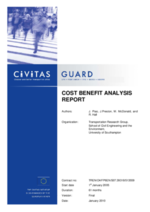Operating clean buses and preparing for a sustainable fuel supply
Summary
In order to have a 100 percent clean bus fleet by 2009, Toulouse planned to purchase buses running on compressed natural gas (CNG) and to open a CNG filling station.
Implementing sustainable mobility
At the end of 2004, before the start of the CIVITAS MOBILIS project, the public transport bus fleet comprised 514 buses, including 100 CNG buses and diesel buses with different Euro emissions standards. The capacity of the only existing CNG filling station was limited to 125 buses. The public transport authority Tisseo and the city of Toulouse implemented the measure with the goal of improving air quality in the conurbation by promoting the use of cleaner vehicles. An accompanying goal was to launch the commercial supply of CNG for private households.
For Tisseo, the aim was to purchase 53 new CNG buses, extending the fleet to 185 vehicles; open a new CNG filling station with capacity for 200 buses; carry out research on CNG engine optimisation; and reduce emissions of pollutants.
For the city of Toulouse, working in cooperation with GDF (the national gas provider and supplier of the gas compressor), the goal was to launch the “CNG at Home” solution by providing micro-compressors for households. This involved building new technical, marketing and commercial tools for use on the French and European markets with the aim of having 1,000 homes equipped with a small compressor at the end of the project.
Progress
At the beginning of 2005, Tisseo purchased 28 new CNG buses and ordered another 40 as part of the MOBILIS project. In parallel, Tisseo opened a second CNG filling station in 2008, permitting some further developments of the CNG fleet.
Between January 2006 and March 2008, GDF marketed its CNG micro-compressor and gave several training sessions to provide the necessary technical knowledge to people installing and maintaining them. In March 2008, in view of the commercial results (58 micro-compressors installed two years after the official launch of the campaign), GDF decided to stop marketing the micro-compressor.
Outcomes
In terms of expanding the CNG fleet, the main objectives were achieved:
- a new gas filling station with a capacity of 200 buses was built;
- Tisseo extended its CNG bus fleet from 100 to 168 vehicles; and
- reductions in pollutant emissions were achieved (carbon monoxide by 75.2 percent; hydrocarbon by 61.5 percent and particulates by 91.1 percent) as a result of replacing old diesel buses with latest-generation CNG buses.
The target of equipping 1,000 homes with micro-compressors was not reached.








